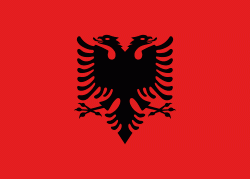Bilisht (Bashkia e Bilishtit)
Bilisht (Bilisht) is a town and a former municipality in Korçë County, south-eastern Albania. At the 2015 local government reform it became a subdivision and the seat of the municipality Devoll. It was the seat of the former Devoll District. The population at the 2011 census was 6,250. The town is 9 km from the border with Greece at Kapshticë. The closest Greek village across the border is Krystallopigi in the Florina regional unit. Bilisht is at 890 meters above sea level and has a continental climate with cool summers and cold winters. It serves as an economic centre for the local agriculture, mining, food and textile industries. The football club is Bilisht Sporti.
The town of Bilisht is the most southeastern city of Albania. It is located to the east of the Devoll Valley, about 880-970m above sea level in a hilly relief that stretches from the Devoll River bed to Kokogllava hill over the city and covers an area of 1.4km2. With average altitude 925 m above sea level Bilisht is the second highest city in Albania after Ersekë (1020m above sea level).
The city has a very favorable geographic position as it passes through the motorway link connecting Albania with Greece via the Kapshticë customs that is 7 km east of it. In the north the town is bordered by Bitinckë (3 km east of it), east bounded by the hills of Kokogllava (1140m above sea level), Stranra (1280m above sea level), Sellcë (an early residence near Bilisht) and Vërnik, (5 km east), south is bordered by Vishoçicë (3 km south), while west is bordered by Devoll River and villages like Poloskë (4 km), Kuç (3 km), Baban (5.5 km ) and Hoçisht (6.5 km). Bilisht has a population of about 12,000 and is the capital of the Municipality of Devoll.
The tyrbe (tomb) of the Muslim Sufi saint Qazim Baba is located in Bilisht.
The town of Bilisht is the most southeastern city of Albania. It is located to the east of the Devoll Valley, about 880-970m above sea level in a hilly relief that stretches from the Devoll River bed to Kokogllava hill over the city and covers an area of 1.4km2. With average altitude 925 m above sea level Bilisht is the second highest city in Albania after Ersekë (1020m above sea level).
The city has a very favorable geographic position as it passes through the motorway link connecting Albania with Greece via the Kapshticë customs that is 7 km east of it. In the north the town is bordered by Bitinckë (3 km east of it), east bounded by the hills of Kokogllava (1140m above sea level), Stranra (1280m above sea level), Sellcë (an early residence near Bilisht) and Vërnik, (5 km east), south is bordered by Vishoçicë (3 km south), while west is bordered by Devoll River and villages like Poloskë (4 km), Kuç (3 km), Baban (5.5 km ) and Hoçisht (6.5 km). Bilisht has a population of about 12,000 and is the capital of the Municipality of Devoll.
The tyrbe (tomb) of the Muslim Sufi saint Qazim Baba is located in Bilisht.
Map - Bilisht (Bashkia e Bilishtit)
Map
Country - Albania
 |
 |
| Flag of Albania | |
Albania has been inhabited by different civilisations over time, such as the Illyrians, Thracians, Ancient Greeks, Romans, Byzantines, Venetians, and Ottomans. The Albanians established the autonomous Principality of Arbër in the 12th century. The Kingdom of Albania and Principality of Albania formed between the 13th and 14th centuries. Prior to the Ottoman conquest of Albania in the 15th century, the Albanian resistance to Ottoman expansion into Europe led by Skanderbeg won them acclaim over most of Europe. Albania remained under Ottoman rule for nearly five centuries, during which many Albanians (known as Arnauts) attained high-ranking offices in the empire, especially in the Southern Balkans and Egypt. Between the 18th and 19th centuries, cultural developments, widely attributed to Albanians having gathered both spiritual and intellectual strength, conclusively led to the Albanian Renaissance. After the defeat of the Ottomans in the Balkan Wars, the modern nation state of Albania declared independence in 1912. In the 20th century, the Kingdom of Albania was invaded by Italy, which formed Greater Albania before becoming a protectorate of Nazi Germany. Enver Hoxha formed the People's Socialist Republic of Albania after World War II, modeled under the terms of Hoxhaism. The Revolutions of 1991 concluded the fall of communism in Albania and eventually the establishment of the current Republic of Albania.
Currency / Language
| ISO | Currency | Symbol | Significant figures |
|---|---|---|---|
| ALL | Albanian lek | L | 2 |
| ISO | Language |
|---|---|
| SQ | Albanian language |
| EL | Greek language |















